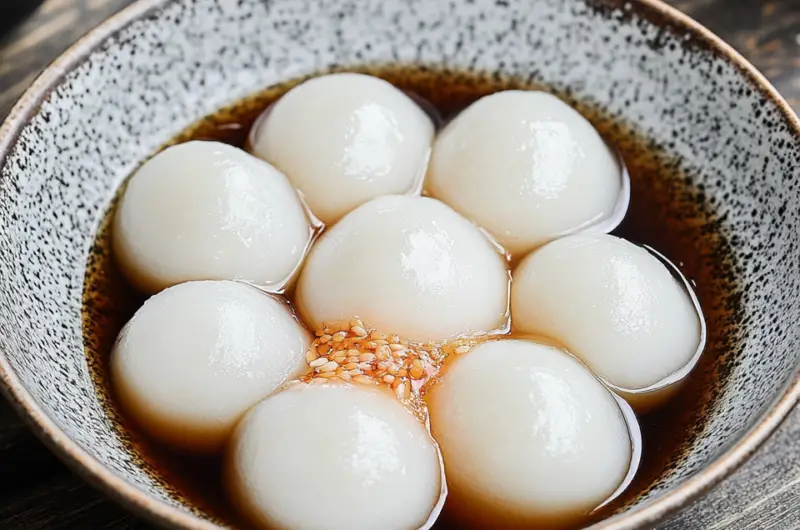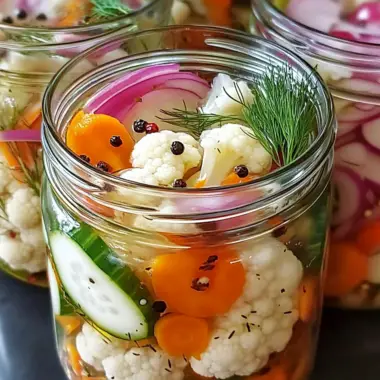Shiratama Dango is a delightful traditional Japanese sweet made from shiratamako, a refined glutinous rice flour that gives the dumplings their iconic soft and chewy texture. These simple rice flour balls are quick to prepare and incredibly versatile, traditionally served with a variety of toppings like sweet red bean paste, kinako (roasted soybean flour), or fruit. Their tender bite and neutral taste make them the perfect canvas for both traditional and modern flavor combinations. Whether you’re exploring wagashi (Japanese sweets) for the first time or you’re a long-time fan of mochi-based desserts, Shiratama Dango is an easy and enjoyable treat to make at home. The preparation is as meditative as it is rewarding, involving gentle mixing, rolling, and boiling. Ideal for tea time, dessert, or even an elegant addition to a bento, these chewy dumplings are sure to bring a taste of Japan right into your kitchen.
Full Recipe:
Ingredients:
-
100g shiratamako (glutinous rice flour)
-
80-90ml water (adjust as needed)
-
Anko (sweet red bean paste), kinako (soybean flour), or fruit for topping
-
Optional: brown sugar syrup (kuromitsu), matcha, sesame seeds
Directions:
-
In a mixing bowl, add shiratamako and slowly pour in water, mixing with your hands until the dough comes together and is smooth like an earlobe.
-
Divide and roll the dough into small, bite-sized balls.
-
Bring a pot of water to boil, and gently drop the balls into the boiling water.
-
Once they float to the surface, continue boiling for 1-2 minutes.
-
Use a slotted spoon to remove the dumplings and place them immediately in a bowl of ice water to cool.
-
Drain well, then serve with your choice of toppings: anko, kinako, fruit, or a drizzle of kuromitsu.
Prep Time: 10 minutes | Cooking Time: 5 minutes | Total Time: 15 minutes
Kcal: 150 kcal | Servings: 3 servings
Discovering the Delight of Shiratama Dango: Japan’s Chewy Dessert Dumplings
Shiratama Dango is a cherished Japanese dessert known for its simplicity, elegance, and delightful chewy texture. These small, round rice flour dumplings have been part of Japan’s culinary history for centuries, often served with traditional toppings such as sweet red bean paste (anko), kinako (roasted soybean flour), and brown sugar syrup (kuromitsu). Unlike their grilled counterpart, mitarashi dango, which is typically skewered and glazed with a soy-based sauce, Shiratama Dango are boiled and cooled, resulting in a soft and bouncy bite that’s often likened to freshly made mochi.
Whether served at Japanese tea ceremonies, festivals, or as part of an elegant dessert plate, Shiratama Dango represents a beautiful blend of minimalism, versatility, and cultural significance. As the interest in Japanese cuisine continues to grow worldwide, this traditional sweet has found its way into modern kitchens across the globe, where it is appreciated both for its taste and its artistic presentation.
What is Shiratama Dango?
At its core, Shiratama Dango are dumplings made from shiratamako, a special kind of glutinous rice flour. Unlike regular mochiko (sweet rice flour), shiratamako is milled and then dried into larger granules, resulting in a smoother, chewier texture when cooked. This texture is what gives Shiratama Dango their signature bounce and appeal.
These dumplings are typically shaped into small balls, boiled until they float to the surface, and then cooled in ice water. This simple cooking technique ensures a delicate, toothsome texture that pairs perfectly with both sweet and savory toppings. While traditionally served with Japanese accompaniments, modern variations include everything from tropical fruits and ice cream to matcha drizzles and even chocolate sauces.
The Cultural Significance of Dango
Dango in general holds a special place in Japanese tradition. These rice flour dumplings are enjoyed during festivals, seasonal celebrations, and holidays. They often appear in trios or sets, symbolizing unity, harmony, and the cyclical nature of life. While Mitarashi Dango, Hanami Dango (eaten during cherry blossom season), and Botchan Dango are more commonly associated with festivals, Shiratama Dango is more commonly served chilled, making it an ideal summer dessert.
Their appearance in Japanese art, literature, and media from anime to classic haiku reflects their deep roots in the culture. They are more than just sweets; they are symbols of nostalgia, comfort, and family connection.
Versatility in Toppings and Presentation
One of the most delightful aspects of Shiratama Dango is its adaptability. It serves as a blank canvas for a variety of toppings, each bringing its own flavor and visual appeal. Some of the most popular pairings include:
-
Anko (Sweet Red Bean Paste): A traditional topping that adds earthy sweetness and pairs beautifully with the neutral flavor of the dango.
-
Kinako (Roasted Soybean Flour): Offers a nutty, roasted flavor and a fine powdery texture that contrasts nicely with the chewiness of the dango.
-
Kuromitsu (Brown Sugar Syrup): A rich, molasses-like syrup often drizzled over the top for a deep, caramel-like finish.
-
Matcha: Sprinkled matcha powder or a matcha syrup provides a bittersweet edge and a vibrant green color.
-
Fruits and Ice Cream: Fresh berries, mango, or melon balls make for a refreshing, modern twist. A scoop of matcha or vanilla ice cream alongside adds creamy indulgence.
Shiratama Dango is also popular in anmitsu, a Japanese dessert bowl that includes agar jelly cubes, fruit, syrup, and sometimes a scoop of ice cream. Whether served alone, in a dessert parfait, or as part of a wagashi platter, the presentation of Shiratama Dango is always elegant and seasonally inspired.
Healthier Than You Think
While sweets are not typically known for their nutritional benefits, Shiratama Dango has several features that make it a healthier choice compared to many Western desserts. For one, it is naturally gluten-free, making it accessible to those with gluten intolerance or celiac disease. The basic dumplings contain no added sugar, and sweetness is usually controlled by the choice and amount of topping.
Additionally, when paired with anko (made from azuki beans), it offers a source of plant-based protein and fiber. Kinako is also known for its high protein content and is rich in vitamins and minerals. By choosing less sugary toppings or incorporating fresh fruits, Shiratama Dango can easily become a guilt-free indulgence that fits into a balanced diet.
A Fun Recipe to Make with Family or Friends
Shiratama Dango isn’t just a delicious treat it’s also fun to make. The process of mixing, rolling, and shaping the dough into perfect little spheres can be incredibly therapeutic and is ideal for a weekend kitchen project or a family-friendly cooking activity. Kids, in particular, love the hands-on experience and the satisfaction of seeing the dumplings float to the top during cooking.
Because the base recipe is so simple, it’s easy to scale up, adapt, or color with natural food dyes like matcha or purple sweet potato powder to create a visually striking plate. Some creative cooks even shape their dango into flowers, animals, or themed characters for seasonal celebrations or bento box decor.
How to Store and Enjoy Later
Shiratama Dango is best enjoyed fresh, shortly after cooking, when its texture is at its peak. However, if you need to make them in advance, you can store them in cold water in the fridge for up to 24 hours. To revive the texture after refrigeration, some recommend briefly soaking them in warm water for a few seconds.
Freezing is not ideal, as the texture changes significantly and can become hard or crumbly once thawed. If you’re making a larger batch, consider only boiling what you’ll need and storing the uncooked dough or shaped balls in an airtight container in the fridge for a day.
A Symbol of Elegance in Minimalism
In many ways, Shiratama Dango embodies the Japanese culinary philosophy of wabi-sabi the appreciation of simplicity, impermanence, and the understated. Its beauty lies in its soft white hue, the subtle flavors, and the gentle way it pairs with both tradition and innovation. Whether served during a formal tea ceremony or made casually at home, it never fails to bring a sense of peace and pleasure.
What sets Shiratama Dango apart from other desserts is its ability to cross cultural and culinary boundaries. With its humble ingredients and sophisticated feel, it’s no wonder food lovers around the world are embracing this delightful Japanese treat.
Conclusion:
If you’re looking to explore Japanese desserts or simply want to try something new, Shiratama Dango is the perfect introduction. It’s simple to make, visually charming, endlessly customizable, and rooted in centuries of tradition. Its chewy texture is unlike any Western dessert, offering a sensory experience that is as soothing as it is satisfying.
This dish celebrates the beauty of Japanese sweets while being adaptable enough to cater to modern palates. Whether enjoyed on its own or dressed up for a dinner party, Shiratama Dango offers both flavor and artistry on the plate. Add it to your list of must-try recipes not just as a dessert, but as a cultural experience that bridges the gap between the familiar and the extraordinary.







